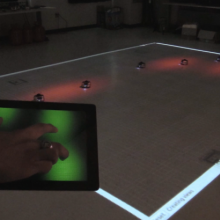A new light-powered robot army technology from Georgia Tech provides user control by simply swiping on a tablet computer. The tiny machines then use communication and cooperation to complete one robot army mission.
While applications for the mini machines are huge, the robotic control is actually quite easy. The only requirements are very basic: a tablet computer and a red beam of light.
To control the robot army, the user simply uses a tablet tap wherever the beam appears. The robots then communicate with each other and calculate the most effective way to cover where the beam hits.
When users want the robots to move, they must swipe a finger across the tablet to transfer the light. The robots will then transfer to that XY axis.
The robot swarm can even use a "divide and conquer" technique. If a user uses two fingers to mark two different locations on the tablet, the machines will then split up and tackle both regions, according to Tech Times.
The new robot army application is not only innovative, but also does not require a robotics degree. Commanding the robot squad is as easy as watching such machines in an exciting Terminator movie or Iron Man movie.
Programming thousands or millions of robots is impossible. Instead, the robot operator controls the region that must be explored.
One practical use of the new technology is search and rescue robots. For example, the user could send a robot group to a damaged building that humans cannot access. The robots would then hunt for survivors and inform emergency personnel when they have accomplished their mission.
Last month Google received a patent for a smartphone-based robotic control system, according to Quartz. However, Georgia Tech's robot algorithm is unique because the robots are able to "change their minds." One simple tablet swipe can send the robot army to a different location.
Yancy Diaz-Mercado, a Georgia Tech Ph.D. candidate, explained that one application for the new robot technology is factory workers sending the machines to different parts of a warehouse. Meanwhile, farmers could order the robots to inspect various crops in a field.



























